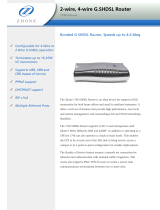
© 2005 Cisco Systems, Inc. All rights reserved.
Important notices, privacy statements, and trademarks of Cisco Systems, Inc. can be found on cisco.com.
Page 3 of 10
Feature Benefits
Analog Voice Interfaces
• Supports analog voice for VoATM/VoIP over AAL5
Standards-Based H.323 Signaling
• Allows an ecosystem of third-party vendors to develop applications for a complete solution; allows
rapid low-cost deployment of VoIP
Digital Signal Processors (DSPs) and
Voice-Compression Codecs G.711,
G.729a, G.723.1, and G.726
• Provide hardware-based compressed voice to fit significantly more voice lines over a single copper
pair without breaking the end-to-end delay budget
Sub-Cell Multiplexing (AAL2) (Cisco
2800, 3800, 2600, and 3700 only)
• Helps enable multiple voice channels to share an ATM cell, leading to efficient bandwidth utilization
Modular Architecture
Variety of WICs, Voice Interface Cards
(VICs), and Network Modules
• Offers added flexibility and investment protection
• Provides easy migration from Frame Relay or asymmetric DSL (ADSL) to SHDSL
Multiple Platform Support
• Supports G.SHDSL WICs across a variety of Cisco platforms, including the Cisco 1841, 2800, 3800,
1700, 2600, 2600XM, 2691, and 3700 series routers
• Reduces cost of maintaining inventory, and allows reuse of modules
Security with VPN and Integrated Firewall
Hardware-Based Encryption
• Helps enable creation of VPNs by providing industry-standard data privacy, integrity, and authenticity
as data traverses the Internet or a shared public network
• Offers hardware-based VPN encryption through onboard processor or Advanced Integration Module
(AIM) VPN card
Triple Digital Encryption Standard
(3DES) IP Security (IPSec), Advanced
Encryption Standard (AES), Generic
Routing Encapsulation (GRE), Layer 2
Tunneling Protocol (L2TP), and Layer
2 Forwarding (L2F)
• Offers choice of standards-based tunneling methods to create VPNs for IP and non-IP traffic
• Offers full interoperability with public certificate authorities and IPSec standards-based products
• Constitutes part of the scalable Cisco end-to-end VPN solution portfolio
Cisco IOS Firewall
• Cisco IOS Firewall includes context-based access control for dynamic firewall filtering, denial-of-
service (DoS) detection and prevention, Java blocking, and real-time alerts
• Allows internal users to access the Internet with secure, per-application-based, dynamic access
control while preventing unauthorized Internet users from accessing the internal LAN
Network Address Translation and Port
Address Translation (NAT/PAT)
• Hides internal IP addresses from external networks
• Prevents certain DoS attacks from outside networks
• Allows multiple users access with a single IP address
Password Authentication
Protocol/Challenge Handshake
Authentication Protocol (PAP/CHAP),
Microsoft CHAP (MS-CHAP), RADIUS,
and TACACS+
• Supports all leading user identity verification schemes
Route and Router Authentication
• Accepts routing table updates from only known routers, helping ensure that no corrupt information
from unknown sources is received
Internet Key Exchange (IKE) and
X.509v3 Digital Certification
• Helps ensure proper identity and authenticity of devices and data
• Supports Certificate Enrollment Protocol (CEP) with certification authorities (CAs) such as Verisign
and Entrust










